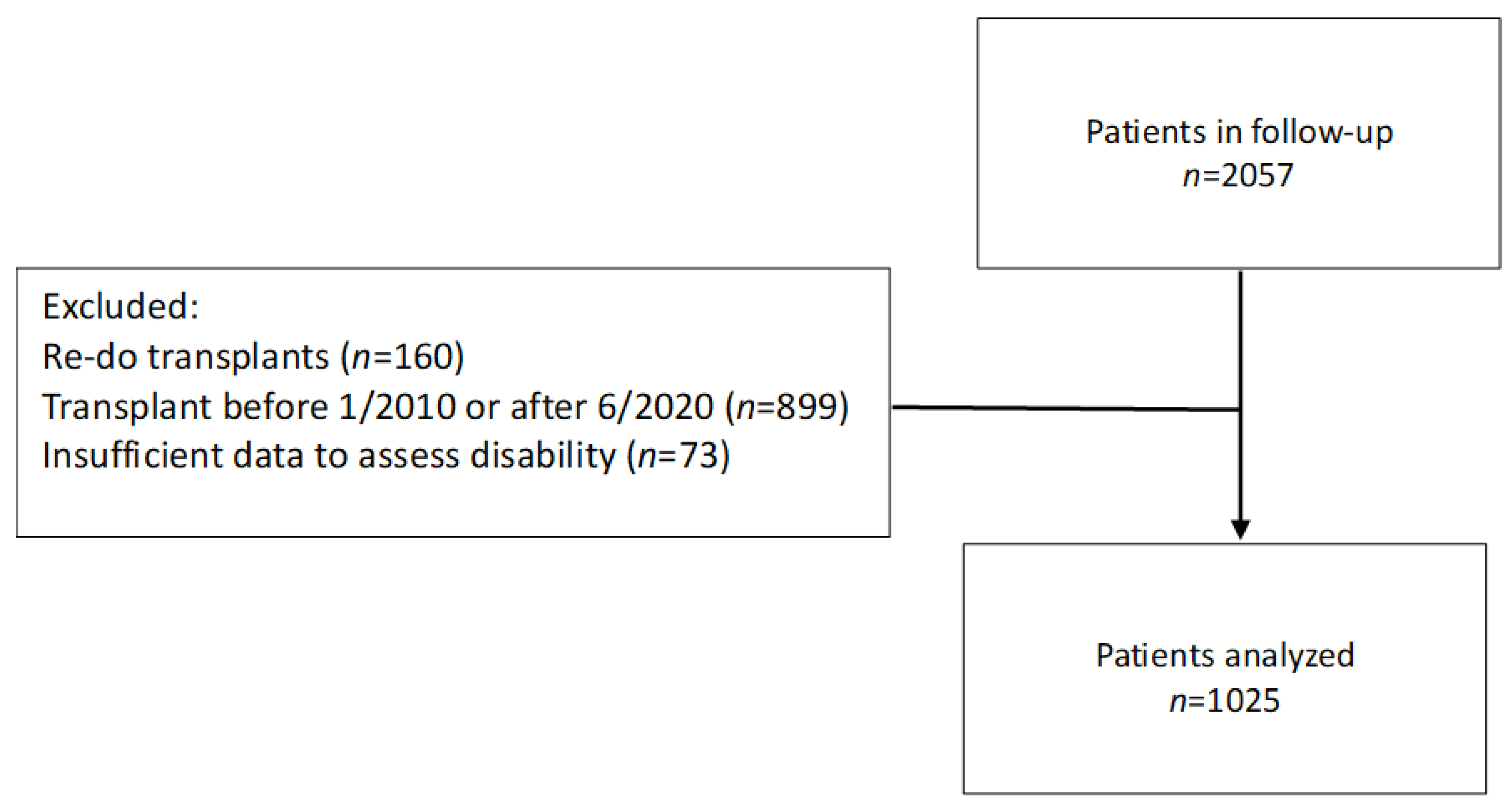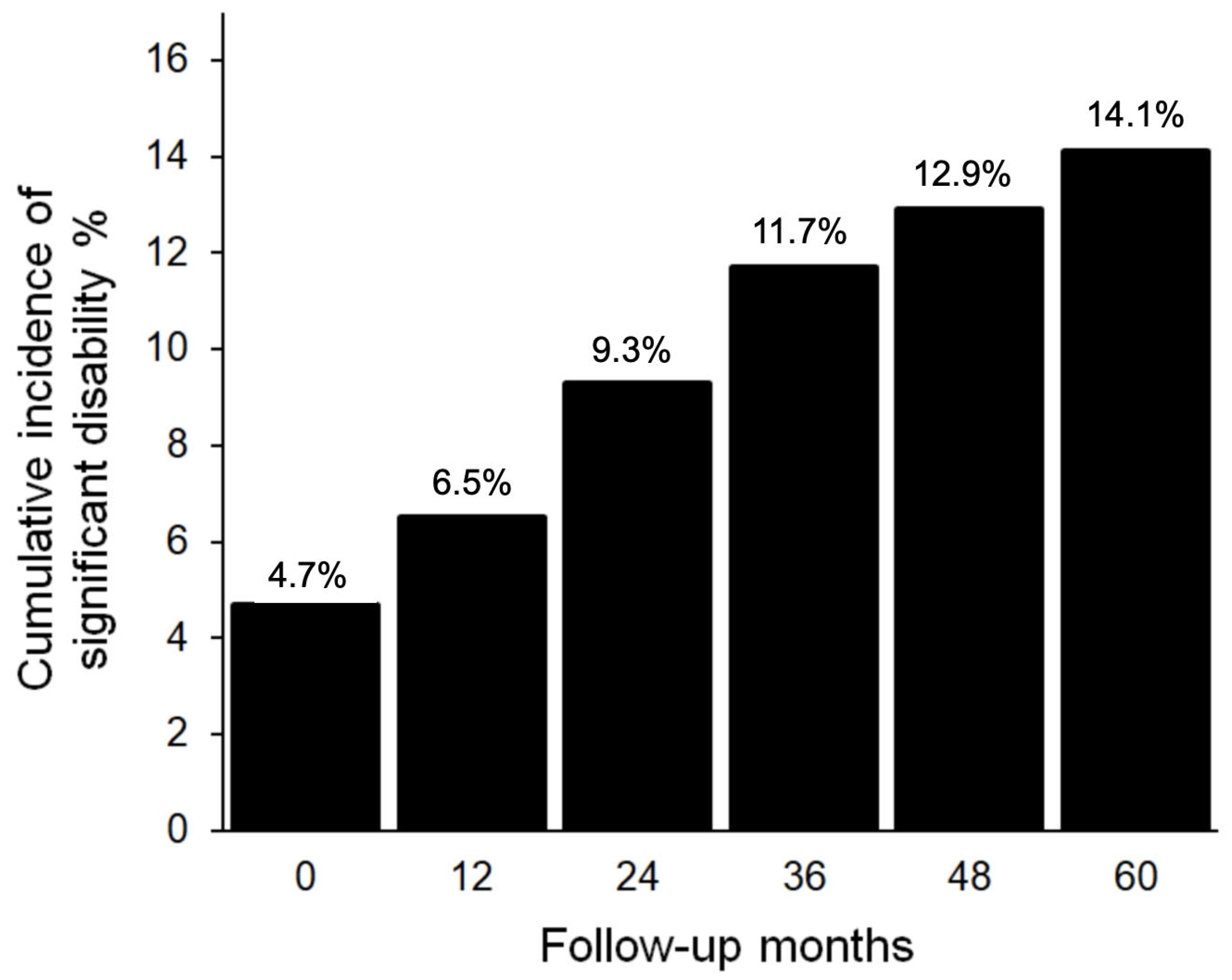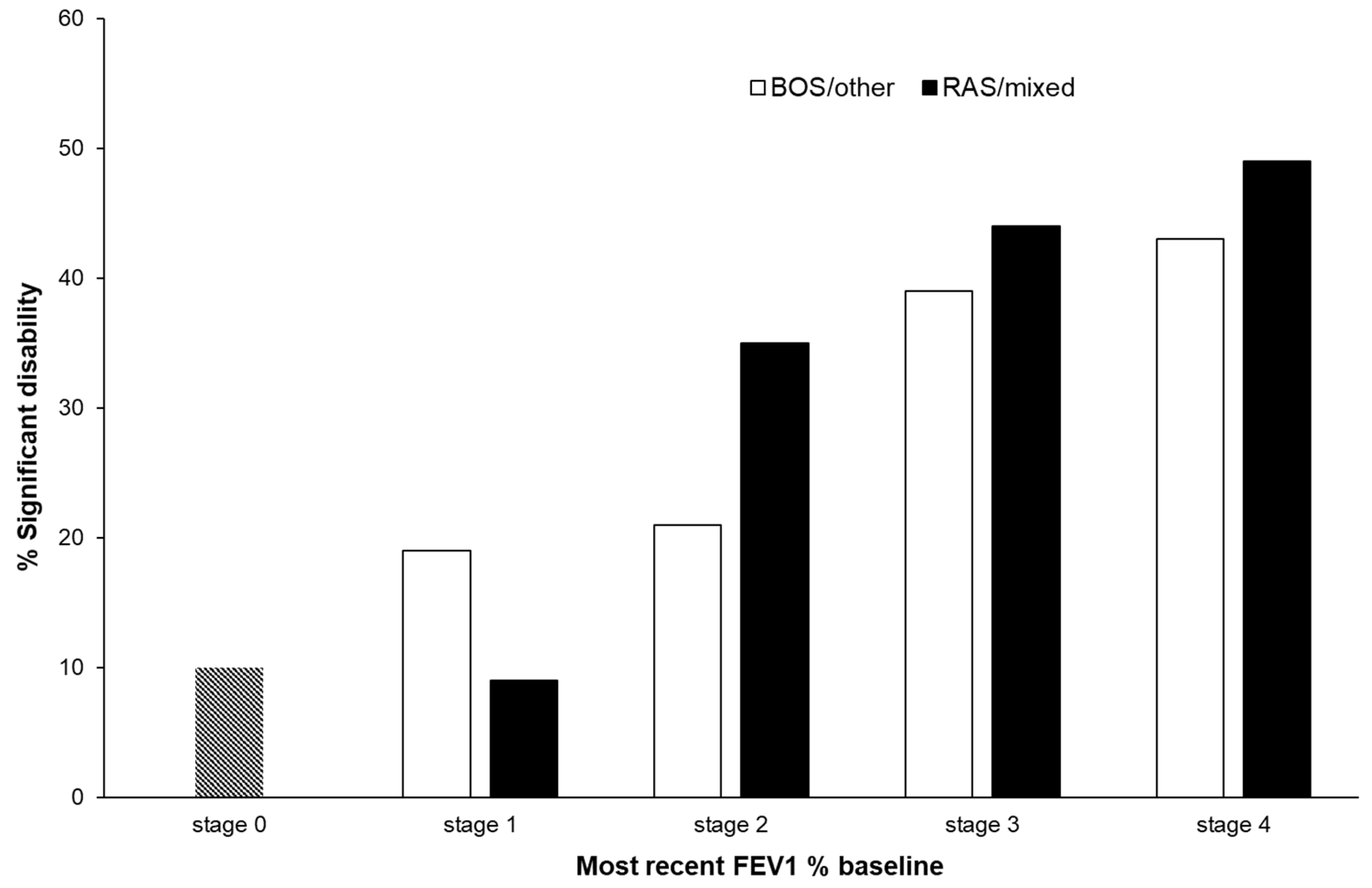Chronic Lung Allograft Dysfunction Is Associated with Significant Disability after Lung Transplantation—A Burden of Disease Analysis in 1025 Cases
Abstract
:Highlights
- One out of four lung transplant recipients in the largest German center develop chronic lung allograft dysfunction (CLAD), which corresponds to chronic lung transplant rejection.
- Transplant patients who develop severe CLAD subsequently lose more than two disability-adjusted life years (DALYs).
- As CLAD disability slowly develops within a median of two years after lung transplantation, there is room for better management of CLAD.
- Beyond already existing options (azithromycin, tacrolimus), new options have to be found for the prevention of CLAD.
Abstract
1. Introduction
2. Methods
2.1. Clinical and Demographic Data Assessment
2.2. Calculation of DALYs
2.3. Statistics
3. Results
4. Discussion
Supplementary Materials
Author Contributions
Funding
Institutional Review Board Statement
Informed Consent Statement
Data Availability Statement
Acknowledgments
Conflicts of Interest
References
- GODT. Organ and Transplantation Activities 2021. Available online: https://www.transplant-observatory.org/2021-global-report-5/ (accessed on 11 October 2023).
- Khush, K.K.; Cherikh, W.S.; Chambers, D.C.; Harhay, M.O.; Hayes, D., Jr.; Hsich, E.; Meiser, B.; Potena, L.; Robinson, A.; Rossano, J.W.; et al. International Society for Heart and Lung Transplantation. The International Thoracic Organ Transplant Registry of the International Society for Heart and Lung Transplantation: Thirty-Sixth Adult Heart Transplantation Report-2019; Focus Theme: Donor and Recipient Size Match. J. Heart Lung Transplant. 2019, 38, 1056–1066, Erratum in J. Heart Lung Transplant. 2020, 39, 91. [Google Scholar]
- Bos, S.; Vos, R.; Van Raemdonck, D.E.; Verleden, G.M. Survival in adult lung transplantation: Where are we in 2020? Curr. Opin. Organ. Transplant. 2020, 25, 268–273. [Google Scholar] [CrossRef]
- Finlen Copeland, C.A.; Snyder, L.D.; Zaas, D.W.; Turbyfill, W.J.; Davis, W.A.; Palmer, S.M. Survival after bronchiolitis obliterans syndrome among bilateral lung transplant recipients. Am. J. Respir. Crit. Care Med. 2010, 182, 784–789. [Google Scholar] [CrossRef]
- Verleden, G.M.; Glanville, A.R.; Lease, E.D.; Fisher, A.J.; Calabrese, F.; Corris, P.A.; Ensor, C.R.; Gottlieb, J.; Hachem, R.R.; Lama, V.; et al. Chronic lung allograft dysfunction: Definition, diagnostic criteria, and approaches to treatment-A consensus report from the Pulmonary Council of the ISHLT. J. Heart Lung Transplant. 2019, 38, 493–503. [Google Scholar] [CrossRef]
- Levy, L.; Huszti, E.; Renaud-Picard, B.; Berra, G.; Kawashima, M.; Takahagi, A.; Fuchs, E.; Ghany, R.; Moshkelgosha, S.; Keshavjee, S.; et al. Risk assessment of chronic lung allograft dysfunction phenotypes: Validation and proposed refinement of the 2019 International Society for Heart and Lung Transplantation classification system. J. Heart Lung Transplant. 2020, 39, 761–770. [Google Scholar] [CrossRef]
- Diel, R.; Lampenius, N. Cost-effectiveness analysis of interventions for tuberculosis control: DALYs versus QALYs. Pharmacoeconomics 2014, 32, 617–726. [Google Scholar] [CrossRef]
- Miller, M.R.; Hankinson, J.; Brusasco, V.; Burgos, F.; Casaburi, R.; Coates, A.; Wanger, J.; ATS/ERS Task Force. Standardisation of spirometry. Eur. Respir. J. 2005, 26, 319–338. [Google Scholar] [CrossRef]
- Wanger, J.; Clausen, J.L.; Coates, A.; Pedersen, O.F.; Brusasco, V.; Burgos, F.; Viegi, G. Standardisation of the measurement of lung volumes. Eur. Respir. J. 2005, 26, 511–522. [Google Scholar] [CrossRef]
- World Health Organization. Global Burden of Disease: 2004 Update; World Health Organization (WHO): Geneva, Switzerland, 2008. [Google Scholar]
- Global Burden of Disease 2019. Available online: http://ghdx.healthdata.org/gbd-results-tool (accessed on 11 October 2023).
- Global Burden of Disease Study 2019 (GBD 2019) Disability Weights. Available online: https://ghdx.healthdata.org/record/ihme-data/gbd-2019-disability-weights (accessed on 11 October 2023).
- The 5-level EQ-5D version (EQ-5D-5L). Available online: https://euroqol.org/eq-5d-instruments/eq-5d-5l-about/ (accessed on 11 October 2023).
- De Vito Dabbs, A.; Dew, M.A.; Stilley, C.S.; Manzetti, J.; Zullo, T.; McCurry, K.R.; Kormos, R.L.; Iacono, A. Psychosocial vulnerability, physical symptoms and physical impairment after lung and heart-lung transplantation. J. Heart Lung Transplant. 2003, 22, 1268–1275. [Google Scholar] [CrossRef]
- Keller, C.A.; Gonwa, T.A.; White, L.J.; Rucci, M.E.; Visscher, S.L.; Kennedy, C.C.; Naessens, J.M. Utilization and cost analysis of lung transplantation and survival after 10 years of adapting the lung allocation score. Transplantation 2019, 103, 638–646. [Google Scholar] [CrossRef]
- Sheshadri, A.; Sacks, N.C.; Healey, B.; Cyr, P.; Boerner, G.; Huang, H.J. The healthcare resource utilization and costs of chronic lung allograft dysfunction following lung transplantation in patients with commercial insurance in the United States. J. Med. Econ. 2022, 25, 650–659. [Google Scholar] [CrossRef]
- Sato, M.; Ohmori-Matsuda, K.; Saito, T.; Matsuda, Y.; Hwang, D.M.; Waddell, T.K.; Singer, L.G.; Keshavjee, S. Time-dependent changes in the risk of death in pure bronchiolitis obliterans syndrome (BOS). J. Heart Lung Transplant. 2013, 32, 484–491. [Google Scholar] [CrossRef]
- Dellgren, G.; Kromann Lund, T.; Raivio, P.; Leuckfeld, I.; Svahn, J.; Skov, O.; Magnusson, J.; Scanclad, A. Scandinavian Multicenter Randomized Study Evaluating if Once-Daily Tacrolimus Versus Twice-Daily Cyclosporine Reduces the 3-Year Incidence of Chronic Lung Allograft Dysfunction after Lung Transplantation. Available online: https://ssrn.com/abstract=4420785 (accessed on 11 October 2023). [CrossRef]
- Vos, R.; Vanaudenaerde, B.M.; Verleden, S.E.; De Vleeschauwer, S.I.; Willems-Widyastuti, A.; Van Raemdonck, D.E.; Verleden, G.M. A randomised controlled trial of azithromycin to prevent chronic rejection after lung transplantation. Eur. Respir. J. 2011, 37, 164–172. [Google Scholar] [CrossRef]
- Antonacci, F.; Petroncini, M.; Salvaterra, E.; Bertoglio, P.; Daddi, N.; Lai, G.; Brandolini, J.; Solli, P.; Dolci, G. Lung Transplant Recipients and COVID-19: Report of Two Cases. J. Clin. Med. 2023, 12, 4287. [Google Scholar] [CrossRef]
- Roosma, E.; van Gemert, J.P.; de Zwart, A.E.S.; van Leer-Buter, C.C.; Hellemons, M.E.; Berg, E.M.; Luijk, B.; Hoek, R.A.S.; van Kessel, D.A.; Akkerman, O.W.; et al. The effect of COVID-19 on transplant function and development of CLAD in lung transplant patients: A multicenter experience. J. Heart Lung Transplant. 2022, 41, 1237–1247. [Google Scholar] [CrossRef]
- Goda, Y.; Nakajima, D.; Tanaka, S.; Yamada, Y.; Yutaka, Y.; Unagami, K.; Yoshikawa, M.; Egawa, H.; Date, H. Efficacy and safety of the SARS-CoV-2 mRNA vaccine in lung transplant recipients: A possible trigger of rejection. Gen. Thorac. Cardiovasc. Surg. 2023, 71, 251–257. [Google Scholar] [CrossRef]
- De Zwart, A.E.S.; Riezebos-Brilman, A.; Lunter, G.A.; Neerken, E.C.U.; van Leer-Buter, C.C.; Alffenaar, J.C.; van Gemert, A.P.; Erasmus, M.E.; Gan, C.T.; Kerstjens, H.A.M.; et al. Impact of COVID-19 social distancing measures on lung transplant recipients: Decline in overall respiratory virus infections is associated with stabilisation of lung function. Eur. Respir. J. 2022, 60, 2200085. [Google Scholar] [CrossRef]



| n = 1025 | |
|---|---|
| Gender, female, n (%) | 489 (48) |
| Age at transplant (years), median (25th, 75th percentile) | 52.8 (40.0, 59.0) |
| Transplant procedure, n (%) | |
| Bilateral | 983 (96) |
| Single lung | 25 (2) |
| Heart–lung | 17 (2) |
| Diagnosis, n (%) | |
| Fibrosis/interstitial lung disease | 333 (33) |
| Chronic obstructive pulmonary disease/alpha1ATD | 310 (30) |
| Cystic fibrosis/bronchiectasis | 228 (22) |
| Pulmonary hypertension/pulmonary vascular diseases | 67 (7) |
| Other | 87 (9) |
| Median follow-up, months (25th, 75th percentile) | 51 (27, 82) |
| Visits during follow-up, median (25th, 75th percentile) | 17 (10, 25) |
| Death during follow-up, n (%) | 212 (21) |
| Comorbidities during follow-up | |
| CLAD (persistent FEV < 80% baseline) | 274 (27) |
| CLAD stage 3 or 4 | 117 (46) |
| CLAD phenotype BOS | 157 (65) |
| CLAD phenotype RAS or mixed | 70 (26) |
| CLAD phenotype undefined | 14 (7) |
| Obesity (BMI > 30 kg/m2) | 24 (2) |
| Significant kidney disease (GFR < 30 mL/min/1.73 m2) | 47 (5) |
| Osteoporosis | 27 (3) |
| Malignancy | 23 (2) |
| Insulin-dependent diabetes | 240 (23) |
| Coronary artery disease | 51 (5) |
| Neuropathy | 8 (1) |
| Stroke | 9 (1) |
| Depression/psychosis | 30 (3) |
| Peripheral arterial occlusive disease | 10 (1) |
| Last Charlson comorbidity index, median | 2 (1, 3) |
| Covariate | Significant Disability (Percentage in Brackets) n = 171 (17) | Significant Disability n = 854 (83) | Univariate | Multivariate | ||
|---|---|---|---|---|---|---|
| Odds Ratio (95% CI) | p | Odds Ratio (95% CI) | p | |||
| Gender | ||||||
| Male | 74 (14) | 462 (86) | (Ref) | (Ref) | (Ref) | (Ref) |
| Female | 97 (20) | 392 (80) | 1.545 (1.109, 2.151) | 0.010 | 1.431 (0.998, 2.052) | 0.051 |
| Age at transplant, median years | 53 (43, 58) | 52 (39, 58) | 1.007 (0.995, 1.020) | 0.254 | ||
| Transplant procedure | ||||||
| Bilateral | 166 (17) | 817 (83) | (Ref) | (Ref) | ||
| Single lung | 3 (12) | 22 (88) | 0.656 (0.149, 2.897) | 0.578 | ||
| Heart–lung | 2 (12) | 15 (88) | 0.671 (0.199, 2.268) | 0.521 | ||
| Underlying disease | ||||||
| Fibrosis/interstitial lung disease | ||||||
| No | 113 (16) | 579 (84) | (Ref) | (Ref) | ||
| Yes | 58 (17) | 275 (83) | 1.081 (0.763, 1.530) | 0.662 | ||
| COPD/alpha1ATD | ||||||
| No | 110 (15) | 605 (85) | (Ref) | (Ref) | (Ref) | (Ref) |
| Yes | 61 (20) | 249 (80) | 1.347 (0.953, 1.904) | 0.091 | 1.247 (0.827, 1.879) | 0.292 |
| Cystic fibrosis/bronchiectasis | ||||||
| No | 146 (18) | 651 (82) | (Ref) | (Ref) | (Ref) | (Ref) |
| Yes | 25 (11) | 203 (89) | 0.549 (0.349, 0.863) | 0.009 | 0.656 (0.392, 1.097) | 0.108 |
| PH/vascular disease | ||||||
| No | 153 (16) | 805 (84) | (Ref) | (Ref) | (Ref) | (Ref) |
| Yes | 18 (27) | 49 (73) | 1.933 (1.096, 3.408) | 0.023 | 1.664 (0.862, 3.210) | 0.129 |
| Comorbidity | ||||||
| CLAD | ||||||
| No | 72 (10) | 679 (90) | (Ref) | (Ref) | (Ref) | (Ref) |
| Yes | 99 (36) | 175 (64) | 5.335 (3.774, 7.541) | <0.001 | 5.375 (3.783, 7.639) | <0.001 |
| BMI > 30 kg/m2 | ||||||
| No | 167 (17) | 834 (83) | (Ref) | (Ref) | ||
| Yes | 4 (17) | 20 (83) | 0.999 (0.337, 2.960) | 0.998 | ||
| GFR < 30 | ||||||
| No | 160 (16) | 818 (84) | (Ref) | (Ref) | ||
| Yes | 11 (23) | 36 (77) | 1.562 (0.779, 3.134) | 0.209 | ||
| Osteoporosis | ||||||
| No | 166 (17) | 832 (83) | (Ref) | (Ref) | ||
| Yes | 5 (19) | 22 (81) | 1.139 (0.425, 3.051) | 0.796 | ||
| Malignancy | ||||||
| No | 166 (17) | 836 (83) | (Ref) | (Ref) | ||
| Yes | 5 (22) | 18 (78) | 1.399 (0.512, 3.821) | 0.513 | ||
| Insulin-dependent diabetes | ||||||
| No | 131 (17) | 654 (83) | (Ref) | (Ref) | ||
| Yes | 40 (17) | 200 (83) | 0.998 (0.677, 1.472) | 0.994 | ||
| Coronary artery disease | ||||||
| No | 161 (17) | 813 (83) | (Ref) | (Ref) | ||
| Yes | 10 (20) | 41 (80) | 1.232 (0.605, 2.509) | 0.566 | ||
| Neuropathy | ||||||
| No | 170 (17) | 847 (83) | (Ref) | (Ref) | ||
| Yes | 1 (12.5) | 7 (87.5) | 0.712 (0.087, 5.823) | 0.751 | ||
| Stroke | ||||||
| No | 168 (17) | 848 (83) | (Ref) | (Ref) | ||
| Yes | 3 (33) | 6 (67) | 2.524 (0.625, 10.191) | 0.194 | ||
| Depression/psychosis | ||||||
| No | 162 (16) | 833 (84) | (Ref) | (Ref) | (Ref) | (Ref) |
| Yes | 9 (30) | 21 (70) | 2.204 (0.991, 4.899) | 0.053 | 2.184 (0.922, 5.173) | 0.076 |
| Peripheral arterial occlusive disease | ||||||
| No | 170 (17) | 845 (83) | (Ref) | (Ref) | ||
| Yes | 1 (10) | 9 (90) | 0.552 (0.070, 4.388) | 0.574 | ||
| Age of death: 56.64 years (IQR 11.9) |
| Life expectancy at age of death years (compared to non-CLAD patients): 4.04 |
| Discount rate: 0.03 |
| Age weight: 0.04 |
| Disability weight: 0.408 (0.354–0.722) [12] |
| Age of onset of disability: 54.6 years (IQR 22.2) |
| Duration of disability: 2.04 years (IQR 2.55) |
| Type of DALY used: definition of Murray 1996 [7] |
Disclaimer/Publisher’s Note: The statements, opinions and data contained in all publications are solely those of the individual author(s) and contributor(s) and not of MDPI and/or the editor(s). MDPI and/or the editor(s) disclaim responsibility for any injury to people or property resulting from any ideas, methods, instructions or products referred to in the content. |
© 2023 by the authors. Licensee MDPI, Basel, Switzerland. This article is an open access article distributed under the terms and conditions of the Creative Commons Attribution (CC BY) license (https://creativecommons.org/licenses/by/4.0/).
Share and Cite
Diel, R.; Simon, S.; Gottlieb, J. Chronic Lung Allograft Dysfunction Is Associated with Significant Disability after Lung Transplantation—A Burden of Disease Analysis in 1025 Cases. Adv. Respir. Med. 2023, 91, 432-444. https://doi.org/10.3390/arm91050033
Diel R, Simon S, Gottlieb J. Chronic Lung Allograft Dysfunction Is Associated with Significant Disability after Lung Transplantation—A Burden of Disease Analysis in 1025 Cases. Advances in Respiratory Medicine. 2023; 91(5):432-444. https://doi.org/10.3390/arm91050033
Chicago/Turabian StyleDiel, Roland, Susanne Simon, and Jens Gottlieb. 2023. "Chronic Lung Allograft Dysfunction Is Associated with Significant Disability after Lung Transplantation—A Burden of Disease Analysis in 1025 Cases" Advances in Respiratory Medicine 91, no. 5: 432-444. https://doi.org/10.3390/arm91050033
APA StyleDiel, R., Simon, S., & Gottlieb, J. (2023). Chronic Lung Allograft Dysfunction Is Associated with Significant Disability after Lung Transplantation—A Burden of Disease Analysis in 1025 Cases. Advances in Respiratory Medicine, 91(5), 432-444. https://doi.org/10.3390/arm91050033





